It was announced not too long ago that Jethro Tull's 1979 album, Stormwatch, was getting the 40th anniversary box set treatment. All of their earlier albums have been re-released over the past several years in one format or another. Some have been given the super deluxe treatment that features the original album remixed by one Steve Wilson, unreleased material, live tracks, and, in some cases, a DVD with a concert. Others are of a more modest nature, featuring the obligatory remixes with relevant non-album singles & b-sides. Stormwatch will be getting the former which means a wealth of new songs to look forward to.
The album is the last in what fans call the "folk trilogy" which began in 1977 with Songs From the Wood and continued with Heavy Horses the following year. It's not a bad way to think of this trio but it's not the full story. To be sure, there are many more bits and pieces of what I suppose you'd call the folk music tradition of the British Isles – I'm no Cecil Sharp, mind you – but anyone expecting a bunch of tunes in the vein of Pentangle or Steeleye Span will be gravely disappointed. The folk elements don't come close to traditional song but rather are additional colors in the band's progressive rock palette.
But, for me, what really makes these albums a triptych, is the lyrics which develop themes through common motifs and imagery. At the core they're about a brace of oppositions, namely tradition vs. modernity and rural vs. urban. Ian Anderson takes a Tolkien-esque stance on these albums championing the rural and lamenting the loss of tradition.
Songs From the Wood is by far the most chipper of these records. It's upbeat and celebratory and filled with natural imagery along with a hefty dose of British folklore and myth. There are only a couple references to modernity/cities here and they're littered amongst many more references to birds, trees, celebrating Beltane and the winter solstice, rings of standing stones, etc. Plus there are a couple naughty tunes as well. (With such rustic, earthy, and lusty lyrics, it's little wonder many neo-pagans adore this album.)
In "Jack-in-the-Green" the narrator asks, "Or will these changing times, motorways, power lines keep us apart?" A few songs later the lovers in "Velvet Green" lay under the stars dreaming "of civilisations raging afar".
But it's here that the super deluxe edition helps us see or hear, rather, some foreshadowing of the next couple albums. "Old Aces Die Hard", an outtake from the sessions that gave us Songs From the Wood is lengthy, clocking in at 8'40". It is also much darker than the stuff on the album, excepting "Pibroch" but that song dealt with the personal while "Old Aces Die Hard" is more social critique.
Apparently it was initially called "Dark Ages" as it uses that refrain. This was resurrected for the song that got that name on Stormwatch. It's sung in a more heraldic manner on that version but the link has been established. One line goes "Dark ages, history's karma is rattling its chains" which not only takes a poke at modernity but also prefaces the rather eschatological ideas on Stormwatch. Elsewhere about a verse and a half of the song ended up being used on the Heavy Horses outtake "Living in These Hard Times". ("The bone's in the china, the fat's in the fire…")
Heavy Horses is much less upbeat than its predecessor. Although it retained heaps of rural imagery, it lacks the references to British myth and folklore. Plus the modern and the city intrude.
The opener, "…And The Mouse Police Never Sleeps" begins with a brief purr before reminding us that nature is red in tooth and claw. "Acres Wild" follows with a sprightly jig-like (or is that reel?) quality that contrasts the open spaces of the countryside to the narrow side streets of the city. While on Songs From the Wood the urban was raging, loud, and busy, here it is symbolized by decay as the buildings have shuttered windows and the discos are silent. Also of note is how the rural areas are in touch with tradition as they are described as places "Where the dance of ages is playing still".
The title track concerns draft horses, one of the most unlikely lyrical topics for a rock song ever.
Modernity has dislodged these majestic creatures from their place in rural life – "the tractor is on its way". And in a nod to Stormwatch, the song refers to the day "when the oil barons have all dripped dry".
"Weathercock" ends the album on a somewhat ambivalent note. The singer please for it to "make this day bright/Put us in touch with your fair winds" yet there are portents of Stormwatch where weather generally and winter specifically become a motif: "Did the cold wind bite you?" and "Do you fight the rush of winter?"
One of the outtakes from the Heavy Horses sessions is "Beltane" which is more upbeat and shows that Anderson hadn't really the discarded myth and folklore. Other songs from the super deluxe box set version see the city and its modern trappings continuing to threaten the rural idyll. "Everything in Our Lives" gives us "the sweet sound of oil wells drilling/as the new roads come in". And "Botanic Man" describes mankind "in a spinning world of cars, aeroplanes and high-rise towers". The singers as the titular character if his kids will "sit in the green fields watching the city spreading" as "traffic jams the motorway".
Stormwatch is by far the darkest of the trilogy and perhaps the least folky, although there is still a fair amount of music that can classified as folk rock. It takes the weather metaphor from "Weathercock" and runs with it using winter both figuratively and literally. With a couple of brief exceptions, British folklore and myth is absent along with the verdant countryside.
"North Sea Oil" kicks things off with a look at the greedy oil barons from "Heavy Horses". This was the 1970s, a time of energy crises, after all. "Dark Ages" picks up and builds on its Songs From the Wood-era ancestor and out of the gate asks "Darlings are you ready for the long winter's fall?" The line "The big jet rumbles over runway miles/That scar the patchwork green" shows the rural in retreat. Society is in upheaval as crazed consumers suffer from "ad-man overkill"; bureaucracy is crumbling as "families screaming line the streets". Disorder rules the day. The song doesn't really specify what it is exactly that ushers in this winter but it seems to be modern society, a nebulous concept to be sure, collapsing in on itself. Perhaps a combination of greedy tycoons, incompetent/impotent bureaucrats, and an apathetic populace.
Things get no better on side 2 which begins with "Something's On the Move". I take this song to embrace a more literal winter, namely global climate change which was popularly, though quite mistakenly, thought to mean global cooling in the 1970s. (Anderson tread this ground on 1972's "Skating Away on the Thin Ice of the New Day".) There is talk of "the new wastes of winter". Of this icy storm Anderson sings "Driving all before her/Unstoppable, unstraining/Her cold creaking mass/Follows reindeer down". The penultimate song is "Flying Dutchman", a ghost ship of legend that says any sighting of it portents doom.
While folklore was kept to a minimum on the album with stones and a stone circle being mentioned, the Stormwatch outtakes we have now include "Kelpie" which are mythological water spirits. "Broadford Bazaar" is a beautiful song that fits in with the somber tone of Stormwatch (Out of the north, no oil rigs are drifting/And jobs for the many are down to the few") but also brings back some of the rural imagery with mention of crofters and cottiers (farmers who rent land) as well as the lines "And up on the hill, there's an old sheep that's dying/But it had two new lambs born just a fortnight before." That whole circle of life thing.
The super deluxe box set brings a wealth of unreleased material including "Urban Apocalypse" which has been known to exist for some time so I am glad that it is finally seeing the light of day. I don't know any of the lyrics although the music is said to be heavy. Still, with a title like that, it would have fitted on Stormwatch well but I guess four eschatological songs was just a step too far.
Ian Anderson would go on both within and without Jethro Tull to write more songs that contemplate the urban and the rural, tradition and modernity. (E.g. – "Farm on the Freeway", "The Whaler's Dues", and "Roots to Branches") But the folk trilogy is a concentrated dose of these ideas. And because of this (and the fact that the music is great) I really adore it, despite Stormwatch perhaps going a bit overboard with the Cassandra routine.
Having spent most of my childhood living in Chicago before moving to rural Wisconsin where civilization really did rage afar, the whole rural vs. urban thing is near and dear to my heart. I have lived it. To an extent, the United States was born of it in the form of Thomas Jefferson's agrarian traditions vs. Alexander Hamilton's promotion of manufacturing and commerce. Today in Wisconsin the state's two largest cities, Milwaukee and Madison, are, at best, treated with suspicion and, at worst, loathed and despised, by rural areas. I suppose that this conflict will be with us forever or until everyone lives in massive underground cities as in Isaac Asimov novels.
Another reason I love the folk trilogy is that it helped me gain an appreciation for tradition. Embracing and engaging it has been extremely fulfilling for me. It is quite meaningful for me to view myself as a link in a chain that goes back through the ages and across oceans. Science fiction author Donald Kingsbury wrote "Tradition is a set of solutions for which we have forgotten the problems. Throw away the solution and you get the problem back." I don't think it virtuous to become hidebound by tradition; you have to sift and winnow. But neither is it prudent to discard or ignore the wit and wisdom of our forebears.
The super deluxe Stormwatch box set is out on 18 October.
11 August, 2019
07 August, 2019
Matutinal Meanderings: Am Ende
Read the previous installment of Matutinal Meanderings, Amble On.
I've been meaning to take some photographs of the totems that someone on Baldwin Street makes for some time. Methinks this person (or people) uses a chainsaw but I am not certain about that. And so I headed over there from E. Johnson.
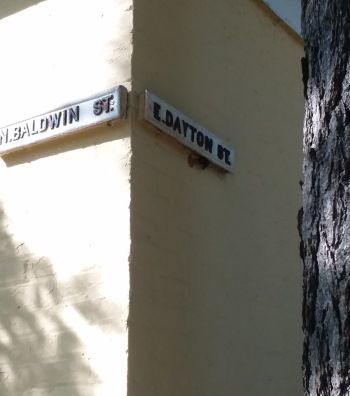
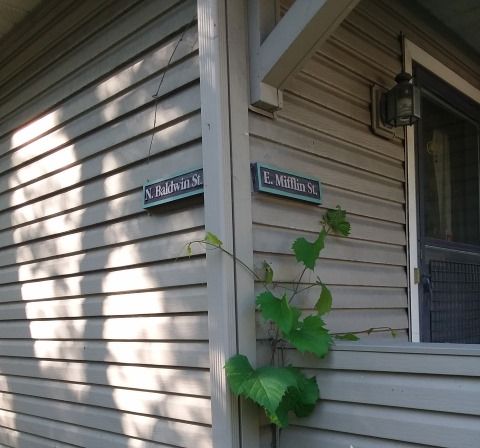
I was hoping that there'd be some of the totems out and that my walk over there would not be for naught. There usually are some to be seen but who knows? Maybe they'd been sold or put into storage or the carver moved. Luckily there were plenty of totems to be seen.

I trekked about some more just idly strolling down the streets. Here's Mifflin Manor which is a wonderfully ironic name considering it's a dreadfully ugly concrete bunker.
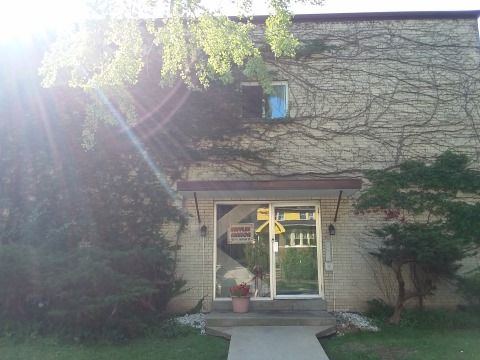
On my final walk down E. Johnson I saw some beautiful homes including the one that is perpetually decorated for Halloween.

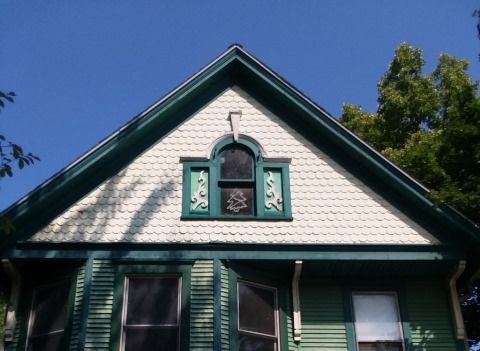
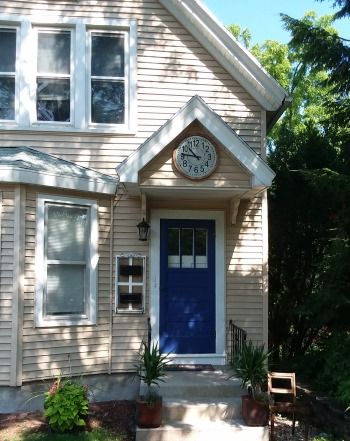
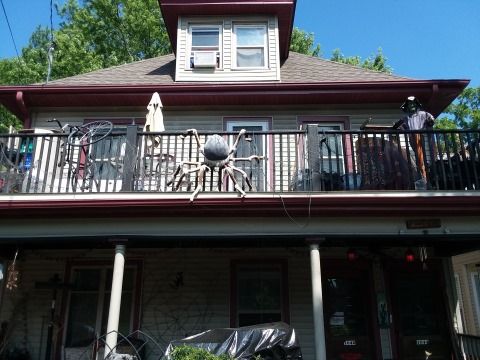
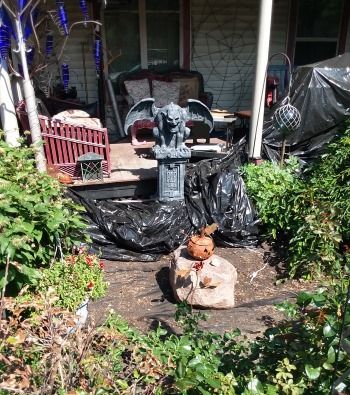
Lastly, I saw this manhole cover. Sure, it's a banal, utilitarian object but it was nice to see such a thing given a little artistic treatment.
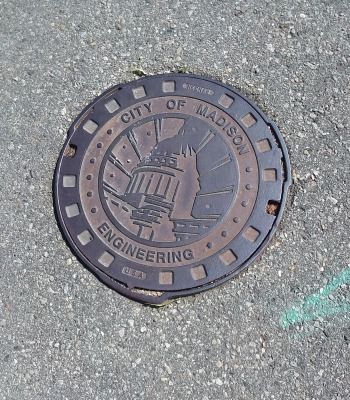
There are surely more around town but I don't recall seeing them.
The Capital Times recently ran a story about gentrification in Madison. It said:
Areas that are beginning to see gentrification or are exhibiting conditions leading toward displacement include the central areas of Tenney-Lapham, Emerson East, Sherman and South Madison. These areas have not seen demographic change but have experienced more rapid rent and property value increases.
Note how it is the central area of Tenney-Lapham that is at the early stage of gentrification. Presumably the homes with lakefront property are and have been gentrified for some time. And the eastern edge of the neighborhood is home to lots of shiny new apartments – The Constellation, Galaxie, the Factory District Apartments, and Lyric Apartments – which cannot be cheap. Plus the Madison Youth Arts Center is coming soon and that plot on the 1200 block of E. Washington which is currently owned by the city for maintenance of fire vehicles will soon be available. Tenney-Lapham is gentrifying; it's a matter of how far it goes and who gets displaced.
I've been meaning to take some photographs of the totems that someone on Baldwin Street makes for some time. Methinks this person (or people) uses a chainsaw but I am not certain about that. And so I headed over there from E. Johnson.


I was hoping that there'd be some of the totems out and that my walk over there would not be for naught. There usually are some to be seen but who knows? Maybe they'd been sold or put into storage or the carver moved. Luckily there were plenty of totems to be seen.

I trekked about some more just idly strolling down the streets. Here's Mifflin Manor which is a wonderfully ironic name considering it's a dreadfully ugly concrete bunker.

On my final walk down E. Johnson I saw some beautiful homes including the one that is perpetually decorated for Halloween.





Lastly, I saw this manhole cover. Sure, it's a banal, utilitarian object but it was nice to see such a thing given a little artistic treatment.

There are surely more around town but I don't recall seeing them.
The Capital Times recently ran a story about gentrification in Madison. It said:
Areas that are beginning to see gentrification or are exhibiting conditions leading toward displacement include the central areas of Tenney-Lapham, Emerson East, Sherman and South Madison. These areas have not seen demographic change but have experienced more rapid rent and property value increases.
Note how it is the central area of Tenney-Lapham that is at the early stage of gentrification. Presumably the homes with lakefront property are and have been gentrified for some time. And the eastern edge of the neighborhood is home to lots of shiny new apartments – The Constellation, Galaxie, the Factory District Apartments, and Lyric Apartments – which cannot be cheap. Plus the Madison Youth Arts Center is coming soon and that plot on the 1200 block of E. Washington which is currently owned by the city for maintenance of fire vehicles will soon be available. Tenney-Lapham is gentrifying; it's a matter of how far it goes and who gets displaced.
06 August, 2019
Matutinal Meanderings: Amble On
Read Part I, "Matutinal Meanderings: A Return to Tenney-Lapham"
Heading out of Giddings Park it was down East Gorham I ambled. My plan was to check out all of the new development on East Johnson but I took a wee detour first. I moseyed up Russell Walk – carefully because the sidewalk probably hasn't seen any work since long before I lived in the area almost 25 years ago. Prospect Place took me to Washburn Place and the other house I resided in when I lived in Tenney-Lapham.
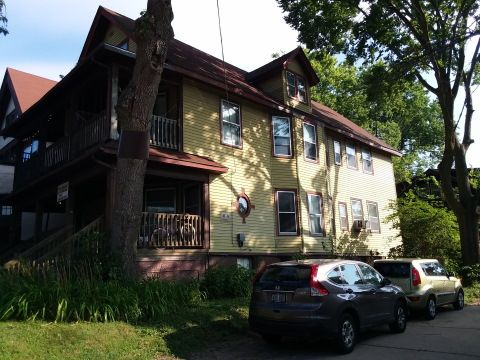
My then-girlfriend and I lived on the top floor and as I walked by I recalled sitting by our living room window listening to The Rolling Stones play "Tumbling Dice" across the lake at Camp Randall.
Washburn Place is a cozy street being only a block long, and a short one at that. It's right by the lake and has one way traffic. To top things off there were a couple mock Tudors across the street with an old pine tree between them. They just gave the street a nice vibe.
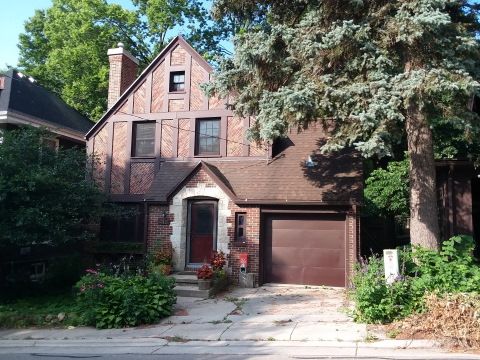
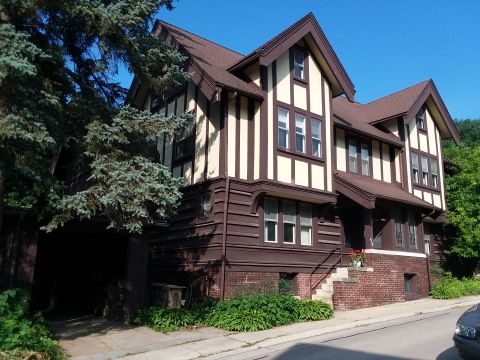
After my brief trip down memory lane, I started once again making my way to E. Johnson. I passed by this house which has a bulkhead door, something of a rarity in Madison.
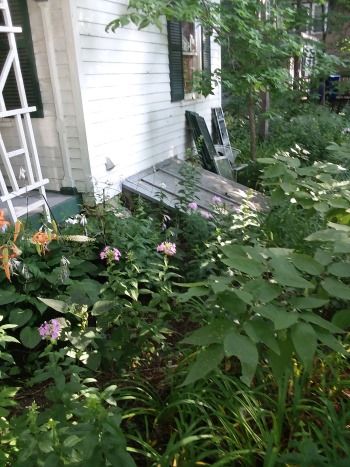
The only other one that comes to mind is the house at Charter and West Johnson.
Soon enough I was at the corner of Blount and Johnson, immortalized in song by Madison's Velveteen Snackcake.
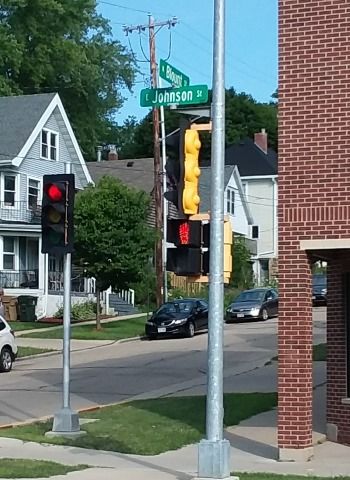
And there was The Caribou, a place I have spent many an hour.
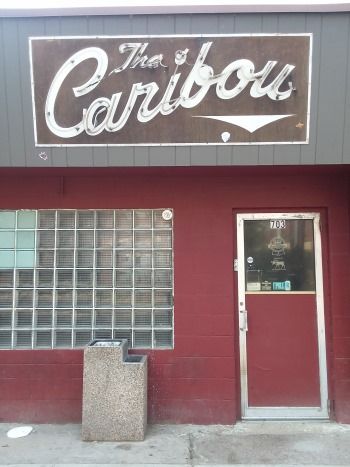
When I lived on Dayton Street we had no air conditioning so my roommate and I would head down there to play cribbage and stay well hydrated with Capital Amber. By the time we got home, we were too tired to notice the heat. A few years later, friends and I would take up a residence there and get to know one of Madison's best bartenders ever, Ruthie.
One time I went there with a friend's father who used to work for the state patrol up in Tomah. Circa 1970 he got assigned to Madison as part of a force that was meant to keep Madison's finest from beating the student protesters too much. When he walked in he flashed back 30 years. He pointed out where a Nesco full of beef used to sit before commenting that it hadn't changed all that much.
Next to The Bou are all the shiny new apartments.
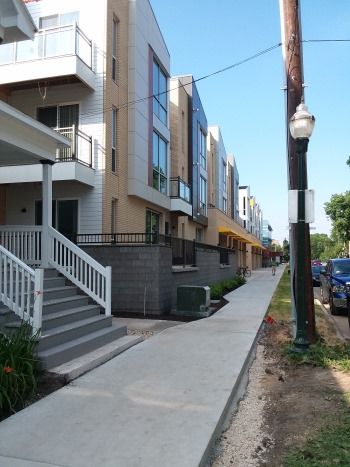
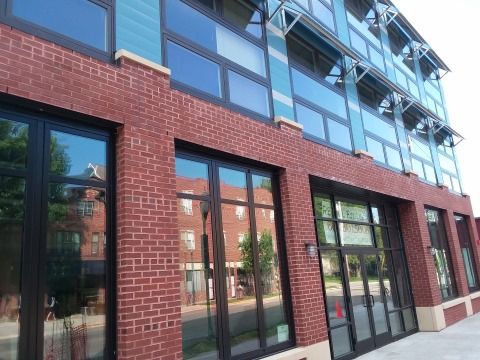
What a shame the developer couldn’t come up with something that was more like the old homes in the area. Not only do these buildings clash with the rest of the neighborhood but they are ugly. At best. Oh well - alia iacta est.
Just up the street the 800 block of E. Johnson is Tenney-Lapham's commercial center. Good Style Shop has a mural which was surely painted by the same person that did those for Next Door Brewing and Banzo Shük.
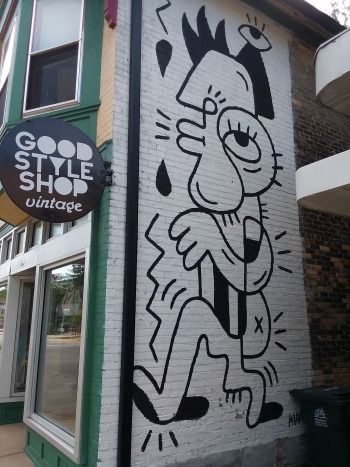
I can personally attest that Little Tibet is quite tasty.

Next to a luthier is the Cork 'n Bottle liquor store which I of course frequented on many an occasion. I fondly recall Jimbo holding court on his banjo as I perused the beer selection.
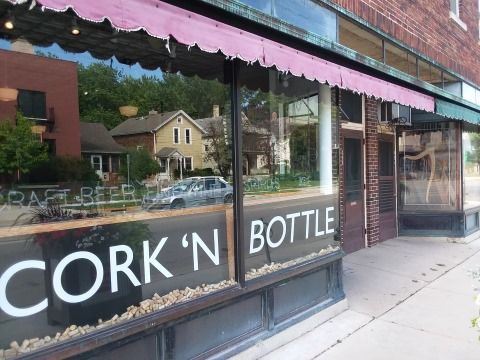
The store gave its name to Madison's beloved bluegrass group, the Cork 'n Bottle String Band.
Across Paterson Street is a place for all of your lapidary needs, Burnie's Rock Shop.

There's also a coffeehouse, an outpost of Salvatore's Tomato Pies, and a smattering of other businesses. Last year the Frau and I were at Salvatore's and I looked out the window only to see 14 storeys of the Galaxie (or was that the Constellation?) off in the distance. Things have certainly changed over the years. I don't have the numbers but there is surely more money in Tenney-Lapham these days.
I just looked up prices for those new apartments on the 700 block of E. Johnson. A 500 square foot studio goes for $1,225. This is not working class housing. Whether people of lesser means are forced out of the neighborhood remains to be seen. Gentrification need not mean displacement for the poorer residents of Tenney-Lapham.
The car wash still had not called me by this time so I kept going up E. Johnson to hopefully get some snaps of something I've been meaning to photograph for a while but had never gotten around to.
Continue to the finale of Matutinal Meanderings, "Am Ende"
Heading out of Giddings Park it was down East Gorham I ambled. My plan was to check out all of the new development on East Johnson but I took a wee detour first. I moseyed up Russell Walk – carefully because the sidewalk probably hasn't seen any work since long before I lived in the area almost 25 years ago. Prospect Place took me to Washburn Place and the other house I resided in when I lived in Tenney-Lapham.

My then-girlfriend and I lived on the top floor and as I walked by I recalled sitting by our living room window listening to The Rolling Stones play "Tumbling Dice" across the lake at Camp Randall.
Washburn Place is a cozy street being only a block long, and a short one at that. It's right by the lake and has one way traffic. To top things off there were a couple mock Tudors across the street with an old pine tree between them. They just gave the street a nice vibe.


After my brief trip down memory lane, I started once again making my way to E. Johnson. I passed by this house which has a bulkhead door, something of a rarity in Madison.

The only other one that comes to mind is the house at Charter and West Johnson.
Soon enough I was at the corner of Blount and Johnson, immortalized in song by Madison's Velveteen Snackcake.

And there was The Caribou, a place I have spent many an hour.

When I lived on Dayton Street we had no air conditioning so my roommate and I would head down there to play cribbage and stay well hydrated with Capital Amber. By the time we got home, we were too tired to notice the heat. A few years later, friends and I would take up a residence there and get to know one of Madison's best bartenders ever, Ruthie.
One time I went there with a friend's father who used to work for the state patrol up in Tomah. Circa 1970 he got assigned to Madison as part of a force that was meant to keep Madison's finest from beating the student protesters too much. When he walked in he flashed back 30 years. He pointed out where a Nesco full of beef used to sit before commenting that it hadn't changed all that much.
Next to The Bou are all the shiny new apartments.


What a shame the developer couldn’t come up with something that was more like the old homes in the area. Not only do these buildings clash with the rest of the neighborhood but they are ugly. At best. Oh well - alia iacta est.
Just up the street the 800 block of E. Johnson is Tenney-Lapham's commercial center. Good Style Shop has a mural which was surely painted by the same person that did those for Next Door Brewing and Banzo Shük.

I can personally attest that Little Tibet is quite tasty.

Next to a luthier is the Cork 'n Bottle liquor store which I of course frequented on many an occasion. I fondly recall Jimbo holding court on his banjo as I perused the beer selection.

The store gave its name to Madison's beloved bluegrass group, the Cork 'n Bottle String Band.
Across Paterson Street is a place for all of your lapidary needs, Burnie's Rock Shop.

There's also a coffeehouse, an outpost of Salvatore's Tomato Pies, and a smattering of other businesses. Last year the Frau and I were at Salvatore's and I looked out the window only to see 14 storeys of the Galaxie (or was that the Constellation?) off in the distance. Things have certainly changed over the years. I don't have the numbers but there is surely more money in Tenney-Lapham these days.
I just looked up prices for those new apartments on the 700 block of E. Johnson. A 500 square foot studio goes for $1,225. This is not working class housing. Whether people of lesser means are forced out of the neighborhood remains to be seen. Gentrification need not mean displacement for the poorer residents of Tenney-Lapham.
The car wash still had not called me by this time so I kept going up E. Johnson to hopefully get some snaps of something I've been meaning to photograph for a while but had never gotten around to.
Continue to the finale of Matutinal Meanderings, "Am Ende"
Subscribe to:
Comments (Atom)